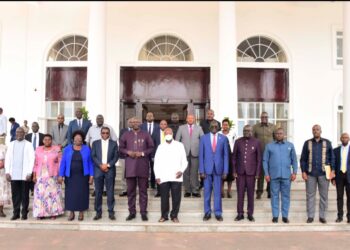By James Musinguzi
Despite volumes of data currently available on mankind, it is surprising how little we know about other species. A paper published in the journal Proceedings of the National Academy of Sciences (PNAS) – using data recorded by Uganda Wildlife Conservation Education Centre in collaboration with other zoos and aquariums worldwide – confirms that critical information, such as fertility and survival rates, is missing from global data for more than 98 percent of known species of mammals, birds, reptiles, and amphibians.
It’s a gap with far-reaching implications for conservationists seeking to blunt the impact of mass extinctions. At a minimum, scientists working worldwide on behalf of IUCN Red List, IUCN Species Survival Commission, Convention on International Trade in Endangered Species of Flora and Fauna (CITES), TRAFFIC, Monitor, and others require more complete data to make informed decisions.
That changed when researchers added data from a previously untapped source, the Zoological Information Management System (ZIMS). Across classes of species, key blanks fill with salient data. A member of the World Association of Zoos and Aquaria (WAZA) and a member of the Pan African Association of Zoos and Aquaria (PAAZA), Uganda Wildlife Conservation Education Centre records animal data in ZIMS, which is curated by wildlife professionals working within zoos, aquariums, refuge, research, and education centers in 97 countries.
It is maintained by Species360, a non-profit member-driven organization that facilitates information sharing among its nearly 1,200 institutional members, and is the world’s largest set of wildlife data. Uganda Wildlife Conservation Education Centre has been contributing data on our animals since 2009. Since then, we have added data on 545 birds, reptiles, amphibians, and mammals of 102 species, making a huge impact on the understanding of those species’ life histories.
“It seems inconceivable. Yet scientists tasked with saving species often have to power through with best-guess assumptions that we hope approximate reality,” said lead researcher and Species360 Conservation Science Alliance director Dalia A. Conde.
A multidisciplinary team led by Species360 Conservation Science Alliance, with participants from 19 institutions, believes we can substantially increase what we know by applying new analytics to data that has been long overlooked – using data contributed by Uganda Wildlife Conservation Education Centre and other zoos and aquariums around the world. “Providing that missing data – filling in those gaps – is game-changing for these species,” adds the Executive Director of Uganda Wildlife Conservation Education Centre, James Musinguzi.
Predicting when species are at risk, and how best to bolster populations, requires knowing at what age females reproduce, how many hatchlings or juveniles survive to adolescence, and how long adults live. To understand what data are currently available, and to measure the void, researchers developed a Species Knowledge Index (SKI) that classifies available demographic information for 32,144 known species of mammals, birds, reptiles and amphibians.
“The demographic knowledge of species index provides significant information that, in conjunction with genetic data, allows estimations of events that affect population viability. Severe population declines, sometimes called genetic bottlenecks, influence the sustainability of populations, as we have found in studying endangered rhinos,” said Oliver Ryder, Ph.D., Director of Genetics, San Diego Zoo Global.
Turning first to go-to global sources of information, the index registers comprehensive birth and death rates for just 1.3 percent of these major classes of species. The map, which illustrates demographic knowledge for individual species, shows that many remain blank.
“Adding ZIMS was like turning on the lights in an otherwise very dim room,” said Conde. “Class by class, from mammals through amphibians, we saw large gaps fill with fundamental data needed to help conservationists assess populations and advocate for threatened, endangered, and vulnerable species.”
Incorporating ZIMS boosted the Species Knowledge Index eightfold for comprehensive life table information used to assess populations. Information on the age of first reproduction for females, a key piece to estimating how a population will fair in coming years, grew as much as 73 percent.
The study, “Data gaps and opportunities for comparative and conservation biology,” suggests a value far beyond the data itself. As Conservation Science Alliance and other researchers apply analytics to data aggregated across global sources, including ZIMS, they glean insights that impact outcomes for species in danger of extinction. Moreover, this can provide key insights for comparative and evolutionary biology, such as understanding the evolution of aging.
The team of 33 scientists including data analysts, biologists, and population dynamics specialists developed the first Species Knowledge Index to map just how much we know about species worldwide. The index aggregates, analyzes and maps data from 22 databases and the IUCN Red List of Threatened species.
About Species360
Species360, a non-profit NGO and global leader in wildlife care and conservation, mobilizes a network of more than 1,100 zoo, aquarium, university, research and governmental members worldwide to improve animal welfare and species conservation. Members address today’s most urgent wildlife issues, including establishing best practices in husbandry, enrichment, medical care, welfare, reproduction, population management, and biodiversity. Together, Species360 members curate the Zoological Information Management System (ZIMS), the world’s most comprehensive open database of knowledge on more than 22,000 species. ZIMS vastly increases what is known about thousands of species, and is instrumental in identifying sustainability strategies for many of the species assessed as vulnerable, endangered, and extinct in the wild.
About Uganda Wildlife Conservation Education Centre (Entebbe Zoo)
Entebbe Zoo was opened in 1952 by the colonial government as a reception Centre for wild animals that were found as casualties (sick, injured, orphaned or/and confiscated from illegal trade). Under the authority of the Game Department, an animal orphanage was created in 1956, to hand raise the orphaned animals received through the Game Department. It became a National Zoo in 1962, in which even non-indigenous species like bears and tigers were kept.
On May 5, 1994, it was turned into the Uganda Wildlife Education Centre (UWEC) and has since grown to be one of the most respected Conservation Education institutions in Africa and beyond, for successfully carrying out its mandates to educate Ugandans on the importance of conserving the country’s biodiversity, to rescue and rehabilitate injured, orphaned and/or confiscated wildlife and to breed endangered wildlife species in captivity with an aim of re-introducing them back in the wild.
UWEC currently holds the chairmanship of all Zoos and Aquaria in Africa (PAAZA) and is a prominent member of the World Association of Zoos and Aquaria (WAZA).Currently, UWEC is the best Zoo in East, West and Central Africa as per PAAZA rankings.
Musinguzi, is the Executive Director at Uganda Wildlife Education Center (commonly known as Entebbe Zoo)
Do you have a story in your community or an opinion to share with us: Email us at editorial@watchdoguganda.com











